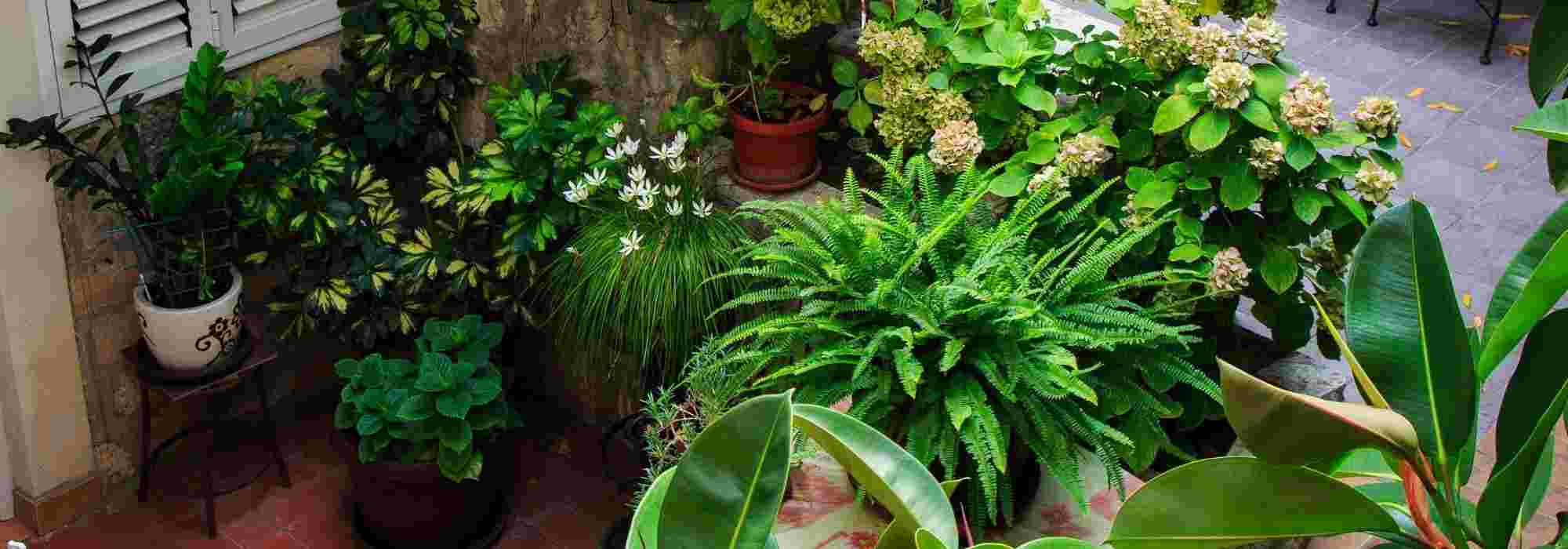
Transform a courtyard into a charming garden: ideas and tips
Design, plant and decorate an urban courtyard — all our tips!
Contents
Do you live in town and are lucky enough to have a courtyard? Even if they may seem dreary, know that courtyards, whether internal or external, offer endless possibilities for layout and planting. A space surrounded by walls, even if it imposes certain constraints (so does a garden, rest assured!), contains qualities other places lack.
Discover how to make the most of a courtyard. Organisation of space, choice of materials, selection of suitable plants, furniture, decoration, lighting… we tell you everything about the elements that can transform a courtyard into a true garden!
Courtyard: advantages and disadvantages
Advantages
- A courtyard can genuinely expand your living space and serve as an extra room to enjoy in fine weather.
- Often enclosed, the courtyard can become a cocoon that shields you from urban tumult and, thanks to walls, offers genuine privacy. If overlooked by neighbouring properties, solutions exist.
- The sun may not often reach a sunken courtyard, but bear in mind that cold or drying winds are also limited there. Walls can also store heat and release it at night, giving you a few precious degrees. It’s an opportunity to welcome more tender plants, such as the magnificent tree fern. (To find out more read our article on plant hardiness.)
- Maintenance of a small courtyard is much reduced compared with a large garden. The small amount of time you devote to it is nothing compared with the pleasure your little paradise returns.
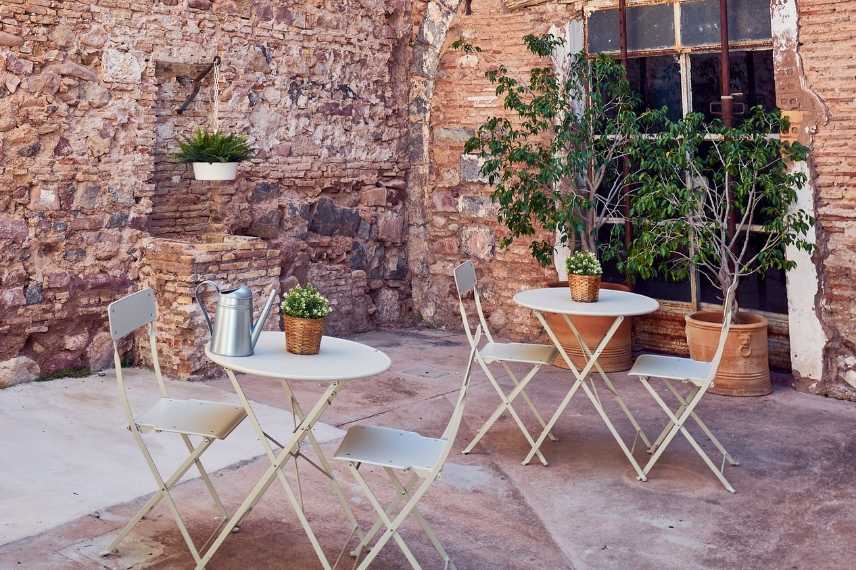
Disadvantages
- Because of often limited dimensions, a courtyard forces you to make choices (planting, layout, decoration). Think carefully about priorities and tastes, and select plants according to their sizes and requirements. Do not, however, forbid occasional use of larger specimens.
- A poorly thought-out cramped space can quickly feel oppressive. There are tricks to visually push back boundaries and make the space appear larger than it really is.
- Depending on region, sun exposure, humidity and winds vary. A small, damp, shady courtyard around Paris cannot be conceived in the same way as one that is warmer, drier and windier on Mediterranean shores, for example.
- Some courtyards do not allow planting in the ground. Don’t panic! Many plants will happily grow in pots. There are perennials, bushes, grasses,and roses that can live in containers for several years. Annuals allow you to change the atmosphere each year, according to your desires.
Organise and divide courtyard space
A small space need not be monotonous! Depending on available space, create different ambiences and areas dedicated to specific activities. Dividing the space also helps make it appear larger.
Here are some ideas for organising your courtyard space :
- Create a seating area (for example, a single chair tucked into the greenery), a play area for children, an outdoor dining area, a vegetable garden (with suitable vegetable plants), a barbecue area (with herbs within easy reach!) or a living display composed of perennials, spring bulbs or summer bulbs and bushes, simply for the pleasure of the eye.
- Play with levels, for example by creating a slightly raised area compared with the rest of the courtyard. Many materials that are easy to work with are now available to build small terraces.
- A corner for bins, bikes or garden tools can, for example, be screened using slatted panels or sheds which you can then cover with climbing plants.
- Install a pergola or an arbour which add undeniable charm while protecting you from the sun or from prying eyes of upper floors.
- An aquatic feature is refreshing and helps mask certain background noises (traffic, passers-by…). A wall fountain, a zinc basin or a simple wooden barrel are easy to install. Enhance them with aquatic plants, which require minimal maintenance.
- Create surprises by placing plants in pretty containers to catch the eye or mark a change of ambience. Learn more in our article Potscaping or container gardening: a modular and portable garden.
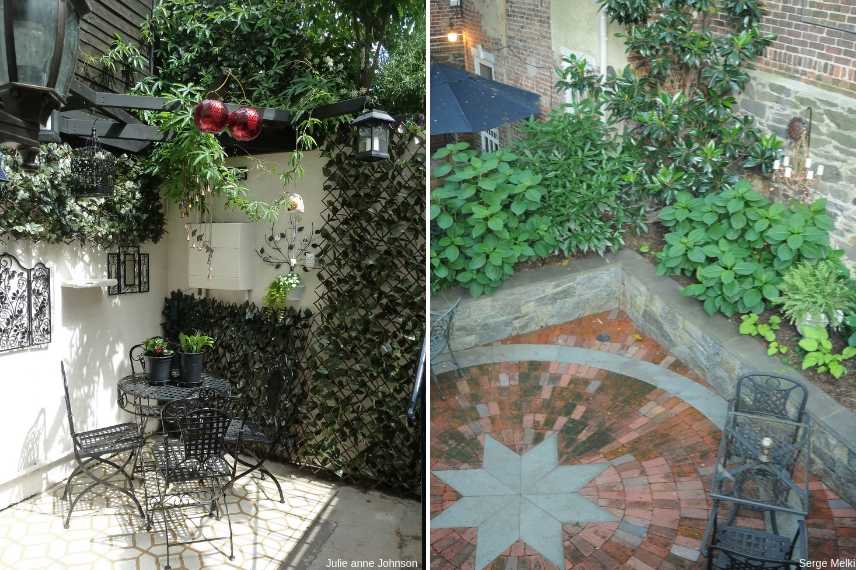
Courtyard with a mini pergola, a small garden seating area and a trellis supporting climbing plants / Courtyard showing a raised planting area
Choosing materials suited to your courtyard
Soil in a courtyard is often hard (concrete, paving…). If you like the look, change nothing! If, however, it makes you depressed, opt for materials that contribute to the atmosphere.
- Be aware that lawn grows poorly, if at all, in shade. If you insist on one, turn to artificial turf.
- For a more natural and original option, use alternative plants to lawn, punctuated with Japanese stepping stones to move around in all weathers.
- Gravel keeps feet dry. At night, it releases stored heat. Choose a diameter large enough so it doesn’t get caught under shoes and lay it, if possible, on a stabilising support such as nidagravel.
- Stone and tiles are durable but their installation is more delicate and they require a larger budget.
- Wood brings warmth and sensuality. Beware, in shaded and damp areas it becomes easily slippery and dangerous.
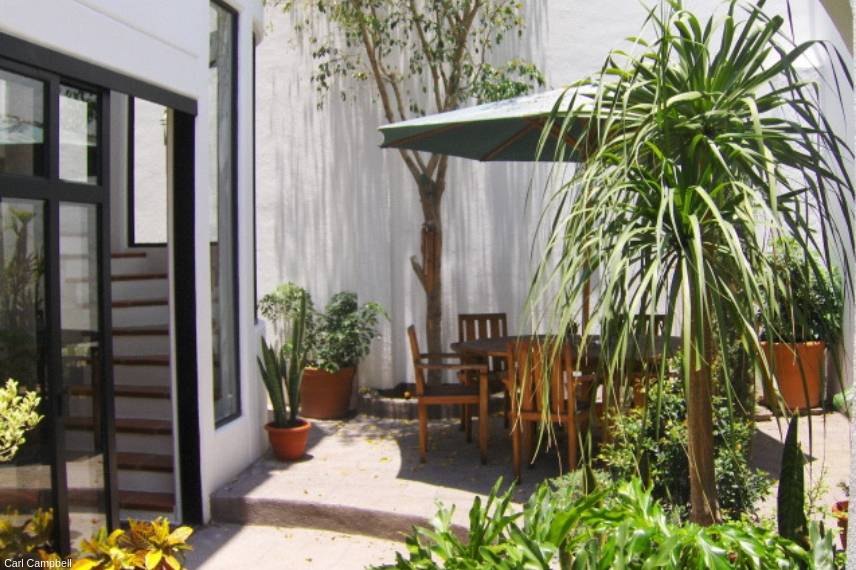
Small courtyard laid out as a welcoming garden
Vegetalizing an urban courtyard
It is entirely possible to make a small courtyard as pleasant as a real garden, and to grow a wide range of plants there.
Which containers to choose?
If you do not have access to open ground, troughs are indispensable. For best effect and good plant growth, observe a few important points :
- Use troughs of generous size, the substrate dries out less quickly. Bespoke troughs allow every desire. Made from old pallets, very on-trend!
- In wood, metal, plastic… choose pots to suit your taste and budget. Take care not to mix styles too much. In a small space, unity is key, otherwise your layout can look like a jumble sale!
- Main drawback of growing in pots is watering. When you go on holiday, this is even truer. There are tips to manage watering during absences. Adding a water retainer to the substrate helps reduce frequency of hose use. To be completely free of this constraint, installing an automatic irrigation system IS the solution. A timer also allows setting watering periods at the most favourable times of day.
- For courtyards entirely surrounded by walls, dress them with climbing plants that blur boundaries, bring freshness and undeniably enhance the place without taking much ground space.
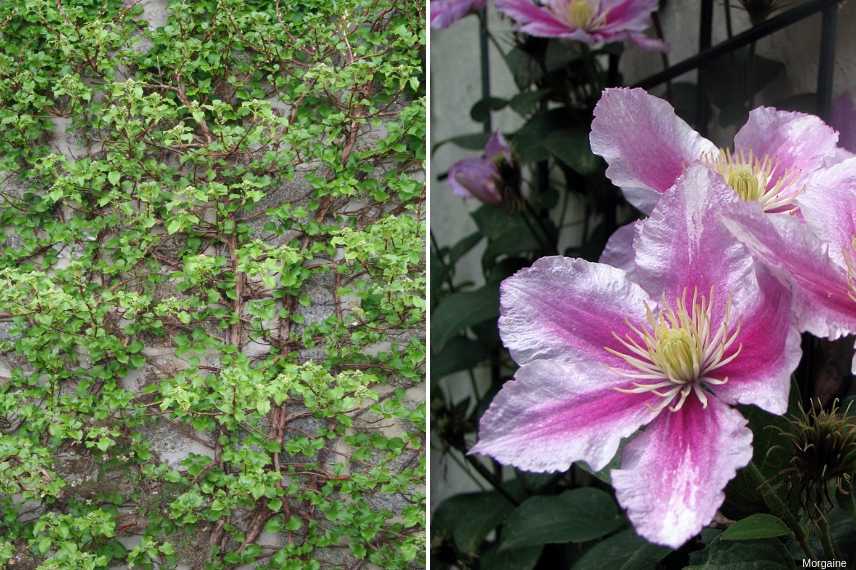
Hydrangea petiolaris (ideal in shade) / Clematis on wooden trellis
Which plants for my courtyard?
Before starting, take inventory of existing plants (if any!). If they are thriving, they give a good indication of the types of plants that suit your space.
Select plants according to exposure. Whether through foliage, flowering or scent, many plants allow creation of true green oases throughout the year. Dwarf cultivars exist, ideal for small spaces.
- Plants for a shady courtyard
Many perennials enjoy shade, including those with decorative foliage: hostas, hakonechloa, ferns, carex and heucheras.
Rely on flowering, notably hellbores, periwinkles, Japanese anemones or certain hardy geraniums. If short of ideas for combinations, read our feature: Design a shady border: which shade plants to choose for your garden?
Among bushes, some also do well in shade or semi-shade, such as pieris, hydrangeas, sarcococcas, aucubas, fatsias, Japanese maples or rhododendrons, to name a few. Always include a few evergreen bushes to keep the scene interesting in winter.
You can choose one or several well-sized bushes, which are easy to keep in proportions suited to the place, especially when grown in troughs.
Cespitose bamboos (non-spreading) allow creation of permanent screens with exotic charm.
Make use of walls with climbers suited to shade. Examples include climbing hydrangeas, schizophragmas, honeysuckles or ivies.
By choosing the right plants, it is entirely possible to grow a vegetable garden in shade.
Don’t forget early-flowering bulbs for colour as soon as spring arrives!
- Plants for a sunny courtyard
Some courtyards can be sunnier, at least in part. Use this opportunity to plant species that enjoy a few hours of sun.
Choice of perennials for sun is very wide. Some offer long flowering periods, such as alstroemerias, agapanthus, asters, nepetas, gauras, erigerons, hardy geraniums (including ‘Rozanne’, a true flower machine!)…choice is vast!

Agapanthus, Gauras, hardy geraniums
Among shrubs, confidently adopt butterfly bushes, dwarf conifers, palms, cordylines, deutzias, crape myrtles, dogwoods (some brighten winter with their coloured wood) or spiraeas.
Enjoy your own harvests thanks to fruit trees adapted to small spaces.
Sunny walls provide support for climbers such as climbing roses, clematis, jasmines, trumpet creepers or wisterias. Their scents come into their own in enclosed spaces.
Ornamental grasses bring lovely lightness. Their maintenance is also extremely limited.
As with shade, spring bulbs awaken your courtyard at first fine days.
Simple rules to green and flower a courtyard
- In all cases, avoid overly bold colour mixes: a ‘pastiche’ effect, quickly reached in a small space, tires the eye. Prefer a limited palette of hues developed in different tones.
- Pair complementary colours such as red and green or blue and yellow. White and grey help link tones together and give elegance. Discover basics of colour matching in our article: How to get colours wrong in the garden in six lessons
- Create contrasts between lighter and darker foliage, bearing in mind that lighter or variegated foliage is generally ideal for the darkest corners.
- Also vary heights to add rhythm and create focal points.
Personalise a courtyard: furniture, decor, lighting…
Once layout is planned and plants selected, one last step remains: personalisation.
- Refresh certain sections of wall if necessary. A light-coloured paint is beneficial as it reflects light. Stronger shades reinforce a particular mood or style, or create backgrounds that showcase plants. Just avoid red flowers against a wall of the same shade, you wouldn’t notice them! Check local regulations. You cannot do whatever you like on a party wall.
- When it comes to furniture, don’t go too big, or you risk overcrowding the space. Upcycling is fashionable and more environmentally friendly. Why not repaint that table and chairs to dine there?
- A small comfortable seat or a well-placed bench allows a quiet moment of reading.
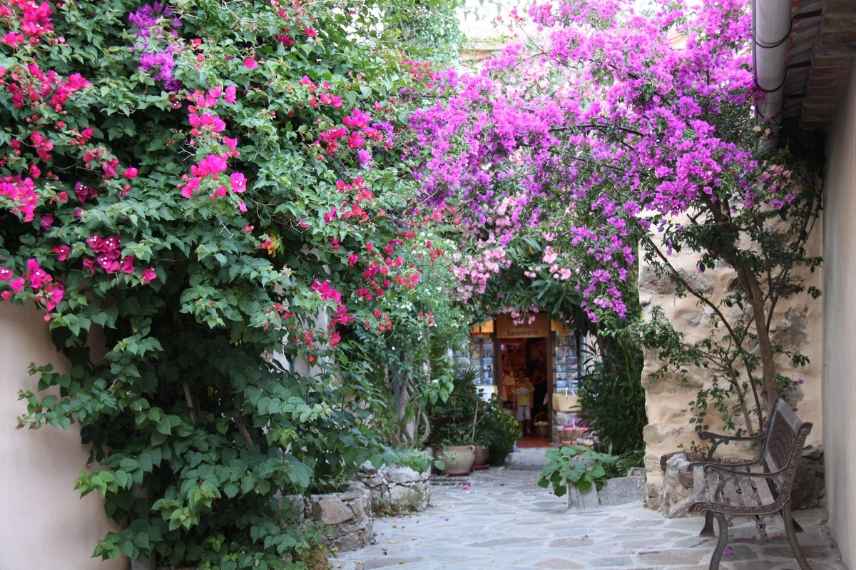
- Give furniture a dual role. A bench can, for example, conceal integrated storage.
- Installing mirrors on walls makes it appear that your ‘garden’ continues and reflects light. Take care, however, of birds that may collide with them. In very enclosed courtyards the risk is lower. Otherwise, you can also place a decorative grille with fairly narrow mesh over the mirror to discourage birds from flying through it.
- A hammock allows restorative naps. It can be put up and taken down in no time.
- Need to screen yourself from an overlooking neighbour? Shade sails are perfect, easy and very quick to install. Another option is to build a small pergola festooned with climbing plants. If it is near openings to the house, opt for deciduous climbing plants that do not block light in winter.
- A small brazier lets you enjoy your outdoor space a little longer and contributes to a ‘cosy’ atmosphere.
- Installing lighting elevates your project as soon as evening falls. They can be connected to the mains to fully play their role or highlight certain plants, but string lights and solar lights, as well as candles placed in pretty lanterns add a dreamy, charming touch.
- Finally, a few flea-market finds or repurposed objects complete your decor. Again, moderation is key. This is not a museum you are creating, but a garden…
- Subscribe!
- Contents



































Comments